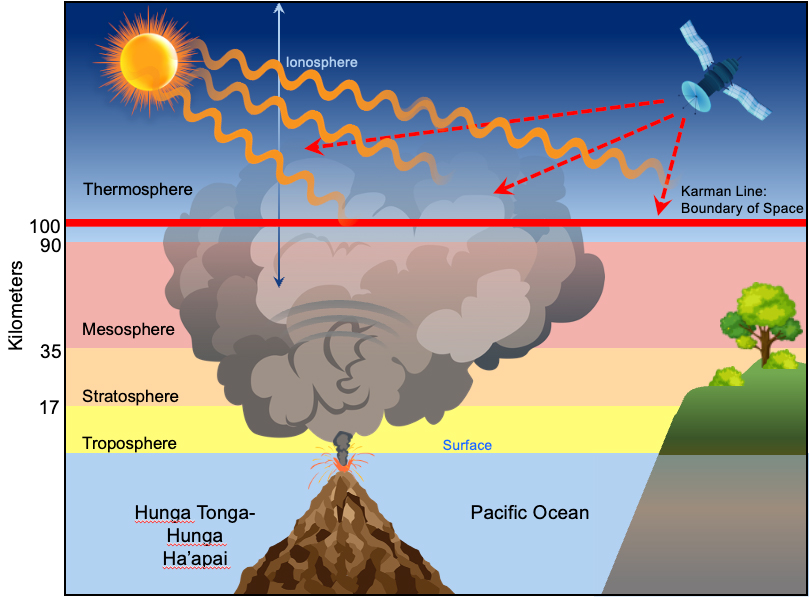The eruption of the mostly submerged Hunga Tonga-Hunga Ha’apai volcano on Jan. 15, 2022, was among the most powerful in the modern era, creating a massive planet-sized shockwave that generated tsunamis and reverberated around the globe for days.

Now, a new study from the Johns Hopkins Applied Physics Laboratory (APL) in Laurel, Maryland, underscores that superlative by showing for the first time that the explosion also blasted water vapor more than 90 miles (144 kilometers) from Earth’s surface, past the boundary of outer space. This extreme event gives scientists a rare opportunity to study Earth as a connected system from the ground — and below — to outer space.
“Although we are still looking through more historic data, thus far, we have never seen anything like this,” said APL space scientist and discovery team lead Larry Paxton. “APL has been providing space weather information to the nation and the science community for more than 20 years. Across this long contiguous record, we have been able to see many phenomena. The Tonga volcano may be a unique event.”
Studying far ultraviolet (FUV) satellite data collected from Earth’s upper atmosphere less than an hour after the eruption, Paxton and his co-investigators noticed an unusual 870-mile-wide (1,400-kilometer-wide) hole in the FUV light right above Tonga — a sign that materials from the volcano had launched high into the atmosphere and were blocking that light from reaching the satellites.
Earth’s upper atmosphere is a source of FUV emissions, which scientists use to track changes in the near-Earth space environment. While FUV light is abundant at this altitude, it is almost completely absent from Earth’s lower atmosphere, where oxygen molecules absorb it. Any changes in FUV observations, consequently, have to be caused by molecules in the upper atmosphere absorbing FUV light, above an altitude of approximately 53 miles (85 kilometers).
As it turned out, the gap the team saw in the FUV observations came from water vapor that the volcano injected 93 miles (150 kilometers) above Earth’s surface — well beyond the boundary between Earth’s atmosphere and space (about 60 miles, or 97 kilometers). The impacted region was approximately 870 miles (1,400 kilometers) wide over the volcano, while the rest of Earth’s upper atmosphere remained unchanged.
The injected material is almost certainly water vapor, not sulfur dioxide, as one might see in a more typical volcanic eruption. Previous studies have shown that this particular eruption only blasted a relatively small amount of sulfur dioxide into the atmosphere, but significantly more water than seen in other eruptions in the modern satellite record. Additionally, the absorption in the satellite observations was consistent with the absorption properties of water.
Using the size of the affected area and the depth of the absorption of FUV light, the team estimated that approximately 200,000 metric tons of water vapor — enough to fill about 100 Olympic swimming pools — affected the signals typically observed. That implies that as much as 4 million metric tons of water vapor could have been injected into outer space.
After approximately 24 hours, the hole in the observations disappeared, indicating that much of the water vapor was destroyed within a day.
This event provides a rare opportunity for scientists to test their understanding of how energy released on Earth’s surface — or, in this case, below the Pacific Ocean — creates global and local-scale changes in near-Earth space; it allows them to see how events in the lower atmosphere are connected to behavior seen in the upper atmosphere.
Additionally, these observations may even suggest an unrecognized link between extraordinary volcano eruptions and the evolution of the upper atmosphere on early proto-Earths, Paxton said, although he acknowledges that is highly speculative.
“We know Earth, Mercury, Mars and Venus had periods of extreme volcanism early in their history,” Paxton said. “We think we understand how Venus and Mars lost their oceans, but could other factors have played a role? Could volcanoes during this early period have created an enhanced escape of light gases like hydrogen? It’s a question that will need more work and consultation with geologists.”
The Defense Meteorological Satellite Program’s Special Sensor Ultraviolet Spectrographic Imagery (SSUSI) and NASA’s Thermosphere, Ionosphere, Mesosphere Energetics and Dynamics Global Ultraviolet Instrument (GUVI) instruments captured the observations used in this study. The SSUSI and GUVI instruments were designed and built at APL.
Related Topics
For Media Inquiries
For all media inquiries, including permission to use images or video in our gallery, please contact:
Michael Buckley
All Media Resources

